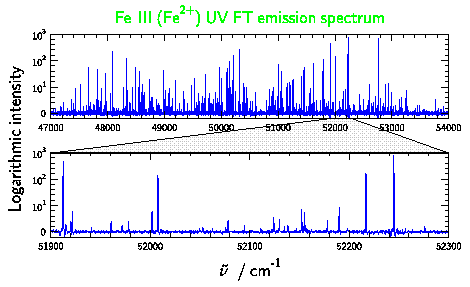Fourier Transform Spectroscopy
|
Our research focuses on laboratory atomic and molecular spectroscopy, particularly for astrophysics
applications. We study these spectra using the technique of Fourier Transform Spectroscopy, across the spectrum:
from the infrared (IR)
, Visible, ultraviolet (UV), to the vacuum ultraviolet (VUV). We also work on the development of Fourier transform spectrometers that operate
in the ultra-violet and vacuum ultra-violet regions of the spectrum.
These instruments, of uniquely high resolving power, efficiency and range,
provide accurate data for the study of planetary atmospheres and stellar plasmas.
Our current research is funded by the STFC of the UK. Previous funders have included: STFC (and formerly PPARC),
The Royal Society, The Leverhulme Trust, and the European Union (Research Training Network).
| |

The Solar Spectrum
Kitt Peak Solar Image Gallery |
|
Atomic Spectroscopy

Our atomic spectroscopy research focuses on the measurement of neutral, singly and doubly ionised transition group spectra to determine the following parameters;
observation of the VUV to IR spectra High Resolution, (resolving power up to 2 million at 200nm) Intensity calibration, typical uncertainty = 3 to 5% Wavelengths Energy levels Line Broadening effects: hyperfine structure and isotope shifts Oscillator strengths, typical uncertainty 5-10%
We have studied spectra of the following elements in recent years: Fe, Mn, Cr, Co, V, Ti, Ni, Mg, Ag, Ta, Mo, Nd and others.
Our measurements are used for fundamental atomic research and theoretical calculations.
However, the majority of our research is applied to the study of space plasmas, including;
- stellar elemental chemical abundances
- Cool stars and brown dwarfs - a stepping stone to extrasolar planets
- Hot Stars, Red Giants, Chemically peculiar stars
- Quasar spectra, for the study of possible time variation of the fine structure constant
Link to: Further details of our atomic spectroscopy research, and applications of our laboratory data.
Link to: ¡Some of our Atomic Spectroscopy recent research highlights for Astrophysics.
|
Molecular Spectroscopy
 Molecular spectra are prominent in spectra of cool stars, brown dwarfs, solar system planets and extrasolar planets. High resolution laboratory molecular spectra are needed fo help in the analysis of stellar and sub-stellar spectra to determine key atmospheric parameters, including chemical abundances, temperature, dynamics and planetary classification. Our current research focusses on the measurement of:
High resolution (R up to 2 million at 200 nm) Low/high temperatures, 160K to 500K Accurate photoabsorption cross sections Wavelengths Isotopic shifts
This link gives further details of molecular spectroscopy projects undertaken by the Imperial College Group, including studies of water, NO, SO2, and O2.
Molecules in Planetary Atmospheres
SO2 is an important constituent of the atmospheres of Io and Venus. Accurate photoabsorption cross-section data at the temperatures of these planetary atmospheres are required for the interpretation of SO2 observations and for reliable photochemical models. The figure is a section of the SO2 spectrum recorded at room temperature using the Imperial College high resolution UV FT spectrometer.
Last updated: 9th August 2022
|
|
|
![]()
![]()